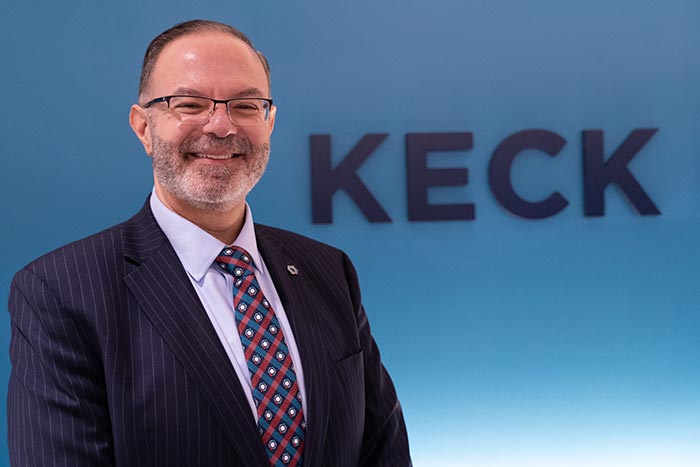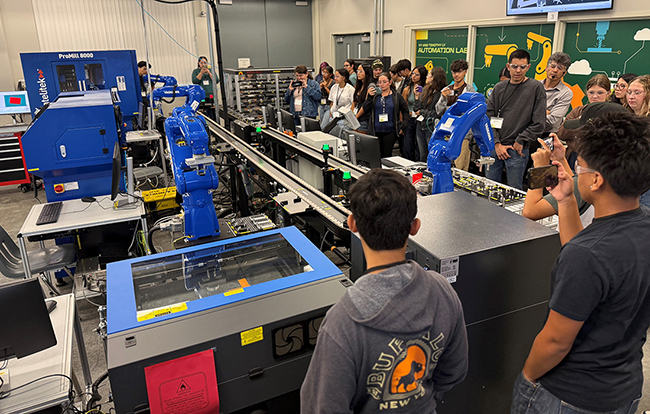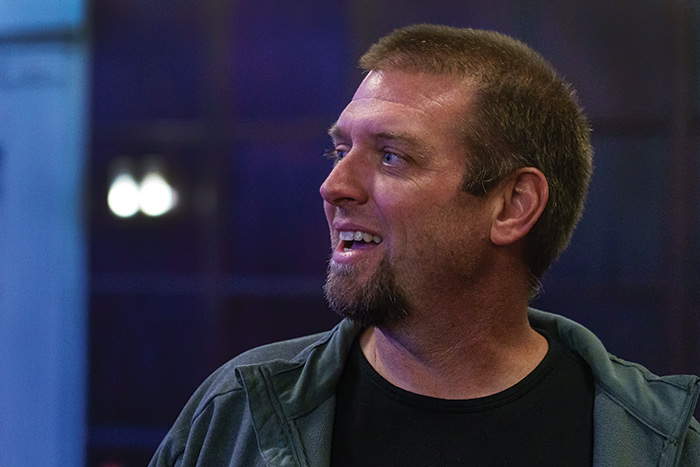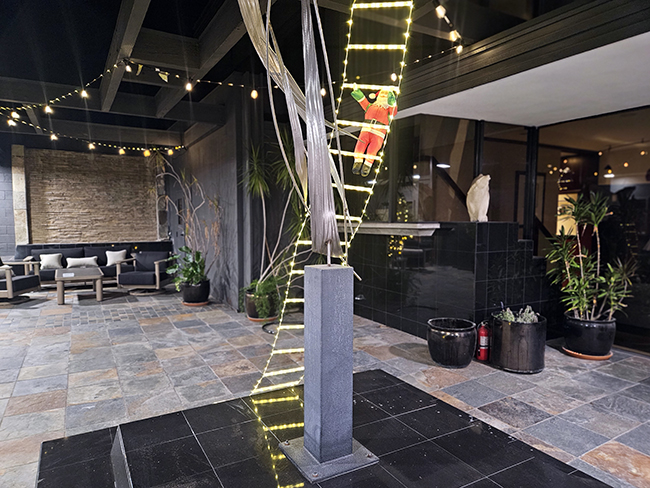New KGI president Abousalem discusses his vision

New Keck Graduate University President Mohamed Abousalem. Courier photo/Andrew Alonzo
by Andrew Alonzo | aalonzo@claremont-courier.com
Keck Graduate University’s third President Mohamed Abousalem hit the ground running after assuming office on July 1, 2024, and is looking to carry that momentum into 2025 and beyond.
The Courier met with the 56-year-old Claremont resident in October. He spoke about his first 14 weeks in office — much of it spent getting to know his new colleagues, students, and the school’s programs — and his vision for the future of KGI.
Abousalem’s selection by KGI’s Board of Trustees followed the retirement of 21-year President Sheldon Schuster, who he acknowledged “left a great mark on the institution and established a platform for growth.” Abousalem arrived with a central mission: build upon the foundation left by Schuster.
“It’s really about adjusting and calibrating how we do things to adapt to the opportunities and address the challenges of the time,” he said.
Abousalem highlighted his four goals in September: to advance academic excellence, enhance the student experience, accelerate institutional maturity and elevate the KGI brand. They were formulated following talks with the KGI’s Board of Trustees, industry advisors, donors, students, faculty, staff, and former president Schuster.
“When you set up the pillars of priorities, they could not be in a vacuum,” Abousalem said. “You have to have them in the context of this institution. What are the areas that we need to advance? What are the areas that we need to focus on to ensure our success and build those in a way that fits the environment, fits the culture of the institution, fits also the outside environment and the opportunity we have? And to articulate it in a way that resonates with the community but also generates buy-in from my community here, my faculty, my staff, to make sure that we can build it together and push forward.
“Every initiative has its own lifeline. Some of them are immediate, some of them are short term,” he said. “Some are mid-term, so we’re saying one to two years and some are long term that we will see the results [in] two years or beyond. And we’ve identified that in the priorities and the operational plan for the institution. So it’s really a mix depending on what we need to do.”
Abousalem was San Jose State University’s first vice president for research and innovation, from June 2019 to June 2024, and was assistant vice chancellor of industry research alliances and IP commercialization at UC Santa Cruz from June 2016 to June 2019. He drew a few parallels from his past roles to his current one.
“When I was hired at San Jose State … they needed a leader to come in and take that platform that had existed and grow it. So over a period of five years, we managed to nearly double the research activity there,” he said. “It was all about growth, which I see here at KGI. At UC Santa Cruz, I went in there to update and upgrade the operation, to again, build and grow. So that’s another parallel.”
For context, he said one aspect in measuring a university’s research output is by looking at its research expenditures. At San Jose State, he grew its research enterprise from $47 million to $87 million. He’s hoping to help KGI grow from $3 million a year to at least $30 million.
To accomplish that ambitious goal, fundraising will be integral.
Abousalem recently announced a $3 million gift had been pledged to support first-generation college students; $1 million was raised to name a campus building the “Sheldon M. Schuster Campus Center”; a research seed innovation fund had been established; and Animesh Ray, professor of systems biology and genomics, received a $750,000 U.S. Department of Energy grant “to use artificial intelligence to study and analyze the effects of low-dose radiation in humans and what is called the ‘bystander effect’ in cells,” according to a news release.
Like Claremont Graduate University, KGI has faced financial uncertainty. “We’ve also experienced years of deficit and we are still in financial deficit when it comes to our budget,” Abousalem said. “But we are not in the same position that CGU is in today. We still have opportunities for funding our deficit through different sources. And that’s really the opportunity for the new president and the new leadership team to look at how we can quickly and effectively turn things around so we can basically have a more, more solid financials moving forward.”
While his fundraising acumen was likely a main factor in his selection, Abousalem said there were certainly other considerations
“They wanted someone also who has a mix of experiences and not just a pure academic or a pure industry person,” he said. “Most if not all my jobs in my career were to either build something from scratch or turn something around, so that’s another reason. And obviously the track record of creating value, which is in some cases is measured by the financials.
“I would say also, the leadership style was also an attraction for the board. And we had discussions about the leadership process and the leadership style and the engagement of the community that I lead and creating that sense of belonging and followership in the community that I lead.”
Abousalem envisions growing KGI’s student population, its industry connections and partnerships under his leadership. His hope is a KGI education equips students to navigate the workforce and the uncertainties of beginning startups, so that they will make a mark in their communities. He sees himself leading KGI for years to come.
“I’ll be here for 21 years,” he joked, referencing his predecessor Schuster’s tenure. “I don’t see myself anywhere beyond KGI. I want to build the future for this institution and see it through. And so that’s really my goal. I just want people to see that I’ve had a positive impact, and I’m not necessarily looking at the impact that just me personally did, I want it to be the impact of … the legacy of my time.”
Abousalem said he keeps students top of mind at all times. “When I first came to this office, I requested to have pictures of students in front of me so every day I look at them — and I do actually look at them often and look at the details there — just to ingrain it in my mind that this is why we’re here.”










0 Comments